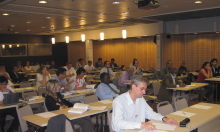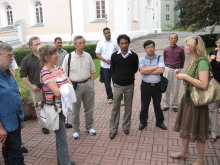Fifth International Conference on Waste Management and the Environment
12 - 14 July 2010
Tallinn, Estonia
Opening Addresses
 The fifth International Conference on Waste Management and the Environment was recently held in Tallinn, Estonia.
The fifth International Conference on Waste Management and the Environment was recently held in Tallinn, Estonia.
The meeting was organised by the Wessex Institute of Technology, UK, the University of Tartu, Estonia, and the University of Nagoya, Japan. The Co-Chairmen were Professor Ulo Mander, from Tartu, Professor Hideaki Itoh from Nagoya and Professors Carlos A Brebbia and Viktor Popov from the Wessex Institute of Technology.
Professor Ulo Mander welcomed the participants to Estonia and explained the history and organisation of his university, which the delegates had occasion to visit at the end of the conference.
Professor Viktor Popov then explained the work carried out at WIT and in particular that of his Division, Environmental Fluid Mechanics. He stated that WIT is keen to collaborate with many institutions around the world and is arranging courses and conferences in different locations.
Previous conferences were held in Cadiz (2002), Rhodes (2004), Malta (2006) and Granada (2008). The meetings provided a platform for the participants involved in waste management to present their latest research and exchange views.
Overview
 Governments around the world have become aware that fast solutions to waste management, mainly relying landfill disposal, cannot offer a sustainable solution in a world with growing populations and ever increasing dynamics of product development for human needs, which are often created by the industry itself. It is not just the volume of waste produced but also the composition and nature of waste often containing compounds which would not decay for centuries or would manifest high toxicity if in contact with the biosphere, that require new ways of dealing with this problem. The approach which encompasses as a most suitable strategy was termed 3R’s, where remediation, re-use and recycle, in this order, are seen as the best activities. Recently, re-think is added as a fourth action (4R’s) applied in order to, for example, recover energy from waste that cannot be reduced, reused or recycled.
Governments around the world have become aware that fast solutions to waste management, mainly relying landfill disposal, cannot offer a sustainable solution in a world with growing populations and ever increasing dynamics of product development for human needs, which are often created by the industry itself. It is not just the volume of waste produced but also the composition and nature of waste often containing compounds which would not decay for centuries or would manifest high toxicity if in contact with the biosphere, that require new ways of dealing with this problem. The approach which encompasses as a most suitable strategy was termed 3R’s, where remediation, re-use and recycle, in this order, are seen as the best activities. Recently, re-think is added as a fourth action (4R’s) applied in order to, for example, recover energy from waste that cannot be reduced, reused or recycled.
Governments respond to this challenge and propose legislation according to the current knowledge in suitable waste management strategies, aiming to direct future sustainable ways of managing waste and forcing many companies and businesses to change not only the way in which they deal with waste, but also to rethink their production line in some cases.
Invited Presentations
There were a series of invited contributions that enhanced the conference;
‘Batch waste gasification technology: characteristics and perspectives’
by P De Philippis, University of Rome La Sapienza, Italy
‘Liquefaction processes and characterization of liquefied products from waste woody materials in different acid catalysts’
by N Kashiwagi, Saitama University, Japan
‘Cultural Heritage and Waste Heritage: advanced techniques to preserve cultural heritage, exploring just in time the ruins produced by disasters and natural calamities’
by M Lega, University of Naples – Parthenope, Italy
‘An index to quantify street cleanliness’
by M Zamorano, University of Granada, Spain
‘Study on coal recovery technology from waste fine Chinese coals by a vegetable oil agglomeration process’
by Q Chen, Saitama University, Japan
‘Monitoring of landfill gas emission rates: application of the static chamber approach to an Italian sanitary landfill site’
by F Tatano, University of Urbino Carlo Bo, Italy
‘Methods for sustainable management of secondary resources’
by A Pehlken, Bremen University, Germany
Conference Sessions
The other presentations were grouped into the following sessions;
- Waste incineration and gasification
- Reduce, reuse and recycle
- Waste management
- Landfills, design, construction and monitoring
- Costs and benefits of waste management options
- Wastewater treatment
- Soil and groundwater clean-up
The conference provided a wide range of presentations dealing with experiences and application of the best technologies and practices together with requirements for future research and technology improvements.
International Scientific Advisory Committee

The International Scientific Advisory Committee of the conference met over dinner to discuss the meeting and put forward new ideas for reconvening the conference in 2012. The meetings list of topics and objectives were reviewed and updated to reflect areas of interest including research. The dinner took place in an excellent restaurant located in the main historical square of Tallinn and was accompanied by good wines.
Conference Dinner
 The conference banquet took place in the building belonging to one of the medieval trading fraternities which existed in Tallinn at the time. These fraternities were distributed throughout the port cities at the time of the Hanseactic League and located in large buildings where merchandises were securely stored and the members could find lodgings. The one visited by the delegates is called the ‘Black Head’ and it’s distinctive motif is the head of St. Maurice. There they had dinner followed by a display of folkloric dances. At the end, the participants were invited to join in the dance with various degrees of success. They returned to the conference hotel in the historic centre of Tallinn where many of them were ready for a final drink! The occasion was most enjoyable, created a nice atmosphere and helped to develop further contacts amongst the participants.
The conference banquet took place in the building belonging to one of the medieval trading fraternities which existed in Tallinn at the time. These fraternities were distributed throughout the port cities at the time of the Hanseactic League and located in large buildings where merchandises were securely stored and the members could find lodgings. The one visited by the delegates is called the ‘Black Head’ and it’s distinctive motif is the head of St. Maurice. There they had dinner followed by a display of folkloric dances. At the end, the participants were invited to join in the dance with various degrees of success. They returned to the conference hotel in the historic centre of Tallinn where many of them were ready for a final drink! The occasion was most enjoyable, created a nice atmosphere and helped to develop further contacts amongst the participants.
Close of the Conference
 At the end of the conference the delegates were invited to visit the University of Tartu. There they were shown the new Campus including the modern buildings and laboratory where Professor Ulo Mander works as well as the old University facilities in town including the main building, site of the Rectorate and the Aula Magna. This is of classical design dating from the early XIX century and surrounded by elegant buildings of the same period. They also visited the old city square dominated by the Town Hall, the oldest in continuous use as such in Europe.
At the end of the conference the delegates were invited to visit the University of Tartu. There they were shown the new Campus including the modern buildings and laboratory where Professor Ulo Mander works as well as the old University facilities in town including the main building, site of the Rectorate and the Aula Magna. This is of classical design dating from the early XIX century and surrounded by elegant buildings of the same period. They also visited the old city square dominated by the Town Hall, the oldest in continuous use as such in Europe.
The conference was closed by Professor Brebbia who explained the wide dissemination of conference books undertaken by WIT Press. This is now in digital as well as paper format. He also encouraged the participants to continue publishing with WIT Press either by submitting papers to the Journals of the Institute (including the International Journal of Sustainable Development and Planning http://journals.witpress.com/pages/jsus/) as well as by publishing edited books or monographs.
Publication of Papers
The proceedings of Waste Management and the Environment V, 496pp (Print ISBN: 978-1-84564-460-4; Online ISSN: 1743-3541) are available from WIT Press priced at £188/US$376/€263. Orders can be placed online at www.witpress.com or by email:
Papers from the conference will also be hosted online in the WIT eLibrary as Volume 140 of WIT Transactions on Ecology and the Environment (ISSN: 1743-3541). For more details visit the WIT eLibrary at http://library.witpress.com


 Wessex Institute
Wessex Institute